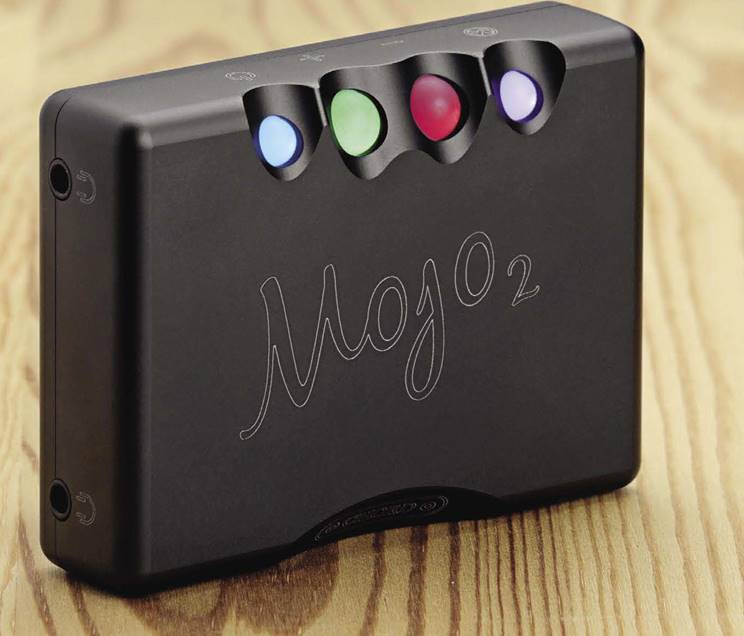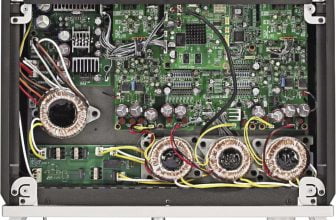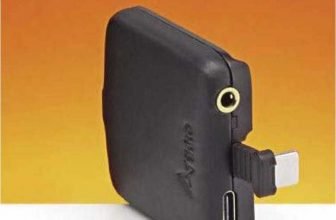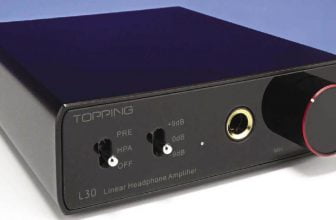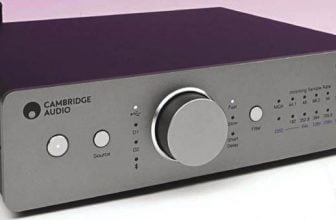CHORD MOJO 2 Review: 2 On cue
Chord Electronics release Mojo 2, updating their popular budget DAC just when needed. Noel Keywood looks closely. Read our CHORD MOJO 2 Review.
It was back in the halcyon pre-bug days of 2016 that Chord Electronics launched the original Mojo portable DAC, purposed for high quality headphone listening from a mobile phone. For that the little Mojo out performed most else: we measured a massive dynamic range of 125dB.The best hi-fi DACs struggled to get close. Recently, days before Christmas 2021, the company released Mojo 2 and sent us a review sample, just in time for me to watch the promo video (instead of Kim Wilde 🙂 over a bit of turkey.
Before I get to the updates, I’ll sketch in the background picture, simply and quickly.The reason Chord Electronics outperform most else is that they design and build their own DACs, designer Rob Watts being No 1 in the field.Whilst DAC chips from ESS of California and – more recently – AKM of Japan, approach Chord Electronics performance figures, they are found in convertors costing thousands. Mojo 2 continues the tradition of offering stellar performance at lower cost.The question arising: why not use it instead of a mainstream convertor? Something I will answer later.
The video I watched over Christmas won’t get an Oscar methinks and I’ll re-run Kim next Christmas, but it made salient points the User Manual could not, talking up additions and improvements that distinguish the new version.The most significant is addition of tone controls! If not of the bass/treble variety from long ago. Instead there are four adjustable frequency bands: lower bass, upper bass, low treble, upper treble, each band adjustable by +/-9dB.This is made possible by a new and – they say – unique ‘UHD DSP (ultra high definition digital signal processor) with a 104bit core running at 768kHz (max). It was very accurate, giving exactly 1dB steps, and was additive so lower bass lift could be combined with upper bass lift for example, but this was a fiddly button pressing process. Settings are retained at switch off and can be quickly removed by pressing up and down buttons together.
There’s talk about super low noise and improved noise shaping to better reveal fine details. Mojo 2 clocked up 125dB dynamic range on our Rohde&Schwarz analyser with volume set to avoid output overload – still better than most mains powered DACs, if no change from Mojo I.
I found it interesting that the company allude to the adoption of an isolated power supply, since this affects its use as a mains powered DAC, run from a 5V USB mobile phone charger – use as a “mainstream DAC” as I said earlier, for use in a hi-fi system.Whilst Chord Electronics don’t play up this role, obviously they’ve catered for it. Point being, a mains power supply can introduce ground noise that degrades performance, something I have seen many times on DACs during measurement. It’s the reason I measure dynamic range using optical connection: it offers ground isolation and an assured best result.
Manufacturers, however, often prefer electrical connection since it allows higher bandwidth / higher sample rate and lower jitter.To make electrical connection work properly in conjunction with a mains power supply Mojo 2 has an isolated supply and, indeed, when running from a mobile phone charger it worked as well as running from battery, measurement showed. A new intelligent charging system prevents battery over-charging in this situation.
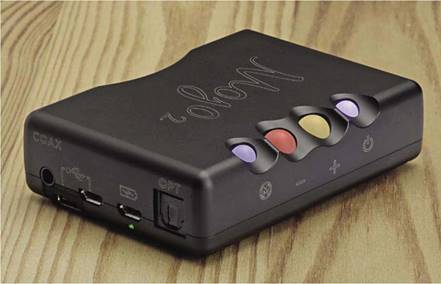
At left is a small 3.5mm stereo jack socket able to accept a digital S/PDIF input in electrical form, or twin inputs from the M Scaler digital filter for CD. Beside it are two USB inputs – microUSB and USB C sockets. Another microUSB is for charging and at front there’s an optical digital S/PDIF input.
Button colours are light spectrum linked: red for low (level or sample rate), ascending through orange, yellow, green, light blue, dark blue, purple, then to white as a maximum.
“There was swathes of fine detail, far beyond that from other portables or most mains powered DACs”
So on the quiet, Mojo 2 has been optimised for use as a mainstream DAC that you can slot into the hi-fi. Don’t expect the bass slam of a mains powered DAC with high current chips but this will be the only drawback.You can connect up a CD player digitally to take advantage of Mojo’s abilities, connecting a headphone output to an amplifier.
A USB C socket (which did not work with my iPhone using a direct Lightning-USB C lead) has been added to complement the microUSB digital input and as before there are optical and electrical S/ PDIF inputs, the latter being through a 3.5mm headphone-style jack. It also accepts a dual channel input from a Chord Electronics M Scaler digital filter, for superb CD quality. The optical input worked up to 176.4kHz, becoming intermittent and unusable with our optical leads at 192kHz; this is an issue with TOSLINK plug fit, not the cables.
Mojo 2 connected successfully to my iPhone via an Apple Lightning- to-microUSB adaptor (as the instructions say) that adds to bulk. It also connects to Android and other types with the usual caveat that a PC needs driver software to transmit sample rates above 96kHz. It will play DSD (up to 256) when sent via DOP from a computer software player able to do this; I used Audirvana. It will also play DSD from an iPhone no less, when packaged as DOP by an Onkyo HF player in my case. With PCM digital, max sample rate is 768kHz. Sample rate is shown by power button colour, red for CD (44.1kHz) and white for DSD for example.
Outputs from Mojo 2 are two 3.5mm stereo jack sockets, without independent control of volume – and there is no balanced output. I don’t find this any great drawback since it only separates a short shared ground line between earpieces that provides slight improvement in sharpness and stereo definition, but I haven’t swapped between unbalanced and balanced with high-end planar magnetic headphones as yet (even though I use Oppo PMIs) where balanced may well be a more obvious benefit.
Output is high at 4.8V sufficient to take insensitive planar magnetics to high volume. Conventional ‘dynamic headphones’ (moving coil drivers) and in-ear monitors (lEMs) only need IV to go shatteringly loud so plenty of leeway here. A Crossfeed facility blends the channels (four settings) to take the images out of the head, simulating loudspeaker listening.
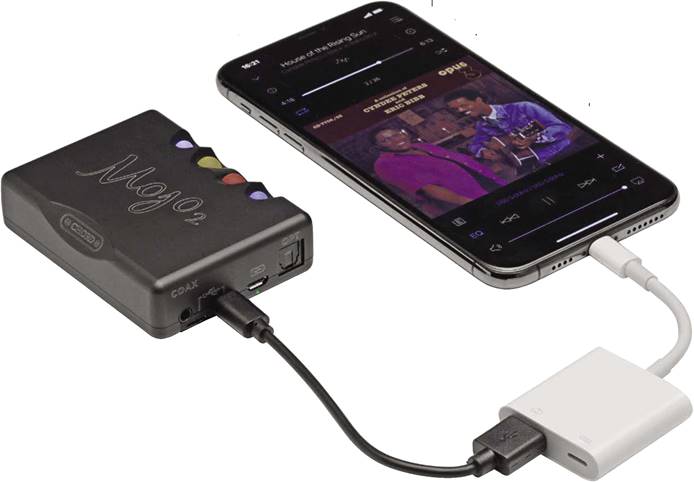
Connection to an iPhone is through an adaptor; a direct Lightning-to-microUSB cable does not work we found. Here an Onkyo HF player app for iPhone sends House of the Rising Sun (DSD) out to Mojo 2 – and not as PCM since Mojo’s indicator (the power button) lit up white, as shown here.
Volume level is shown by colour of the volume buttons that move in two stages, a low range of 0V-30mV output (menu light off), and a high range (menu light on) that is maximum whilst avoiding output overload when both buttons turn ‘white’ (there’s a slightly blue hue). Level can then be increased substantially but overload becomes possible on musical peaks, depending upon how loud a recording has been made.The use for this is to raise volume of low level recordings, which I suspect will be home recordings since commercial music is usually taken to maximum level.
As with other Chord Electronics products there is no input selector: it auto-switches to any input with a signal on it, a very nice touch. With multiple inputs there is a hierarchy (USB C takes precedence).
Machined from alloy, this little device is tough – and feels it. On our scales it weighed a solid I83gms and will fit most pockets, measuring 83mm wide, 62mm high and 23mm deep. The battery gives approximately 8hrs life and a 5V phone charger is needed, able to supply 1.5A.When on the move all buttons can be locked to prevent accidental operation. In use it gets quite warm.
Mojo can be combined with Chord’s Poly streamer whereupon it can read a microSD card, converting it into a player, or stream wirelessly from the ’net.
SOUND QUALITY
To review Mojo 2 I mostly used it as intended, with an iPhone (IIX Pro) as a portable DAC, playing music out from an Onkyo HF player, an app costing just £ in its hi-res version, to Oppo PM1 (planar magnetic) headphones.As a reference I used the same tracks played through a mains powered Audiolab M-DAC+ fed by the Audirvana Plus software player on a Mac.
Generally, running through a whole slew of tracks I got the impression – unsurprisingly perhaps – that Mojo 2’s character and strengths were similar to Mojo I. It excels in midband resolution and projection, with plenty of fine detail. Diana Krall singing Cry Me a River (24/96) came over as super clear and finely etched, bathed in bright light slightly ahead of the mix. Her breathy vocals were made apparent, in a balance that was less expansive and fulsome than the Audiolab, but more insightful.
With Fleetwood Mac’s Go Your Own Way (24/96) vocals were strong centre stage and oodles of fine treble fired from the percussion, whilst drums were drier with less weight and stereo spread than a mains powered DAC. With Giorgio by Moroder from Daft Punk (24/88.2kHz) there was again superb clarity if less shape to the repetitive synth, but then this is always the case when a battery powered device is compared to one that is mains powered. Connecting up to a 5V charger whilst listening made no difference.
What about use as a mains DAC in a hi-fi?This worked well, with enough output to drive a PrimaLuna EV0300 Hybrid amplifier connected to Martin Logan ESL-X hybrid electrostatic loudspeakers. Input came from an Oppo BDP- 205D hi-res player connected by QED Quartz optical cable. Relieved of a Planar Magnetic output load the headphone amp tightened up a little to give tauter and better spread bass across the sound stage, Fleetwood Mac’s Go Your Own Way, revealing the way kick drum is panned on the stage (in the digital transcription). Our electrostatics better displayed this DAC’s superb midrange resolution and especially, its sparkling treble.There was swathes of fine detail, far beyond that from other portables or most mains powered DACs.This was very apparent with Vivaldi’s Concerto in D Minor (DSD 2.8MHz), Mojo’s insight gave a composed sound stage with instruments well separated and firmly anchored, plus insight into strings that were clear and detailed. A fantastic result at the price and quite unique.
CONCLUSION
Mojo 2 has been upgraded to have broader compatibility and more facilities than its seminal predecessor.The extra menu button and light combinations make operation more difficult yet still easier than the buried menu systems of portable players.The tone controls worked well at lower levels, providing subtle adjustment, the shelf controls (upper bass/lower treble) set to +/-2dB being just right to balance out headphone and loudspeaker errors, something that can be useful.With low price and massive ability this is a DAC that in many areas others cannot match. Well worth hearing.
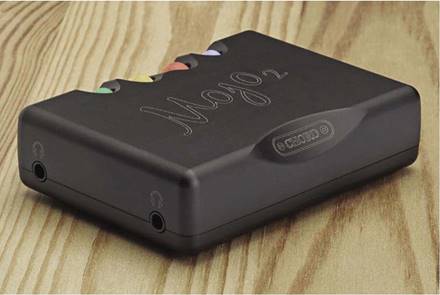
Output for headphones is via two 3.5mm stereo jack sockets. Connection to an amplifier needs a simple adaptor lead with in-line phono sockets.
MEASURED PERFORMANCE
Mojo 2 delivered 4.8V maximum output, from a full scale (0dB) digital input, with volume set to avoid output overload, shown by both volume buttons lighting white.
EIAJ Dynamic Range measured 125dB at this setting, rising to 142dB with volume taken to maximum, a situation only possible with the low level -60dB test signal used for dynamic range measurement.
Distortion was very low 0.014% at -60dB (24bit) and 0.0002% at 0dB. With 16bit distortion measured the usual 0.22% due to quantisation noise being dominant at this bit depth).
Frequency response measured flat to 28kHz (-1dB) via the analogue headphone output, as our analysis shows, output falling away steadily above this frequency to the upper theoretical limit of 96kHz from the 192kHz sample rate test signal. The optical input accepted 176.4kHz maximum, but not 192kHz from our various optical cables that manage 192kHz with other products.
The tone controls give exactly +/-9dB lift/cut in 1dB steps, ‘lower bass’ and ‘upper treble’ applying fine trim at spectrum extremes, whilst the ‘mid bass’ and ‘lower treble’ give shelf lift/cut. Pressing both Up and Down buttons at the same time resets to zero.
With enormous dynamic range, ultra-low distortion and high output, Mojo 2 eclipses all else in its measured performance.
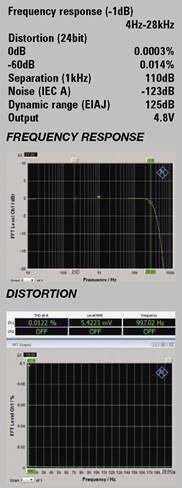
OUTSTANDING – amongst the best.
VALUE – keenly priced.
VERDICT
When you purchase through links on our site, I may earn an affiliate commission. Here’s how it works.
Chord Electronics
+44 (0)1622 721444
www.chordelectronics.co.uk
